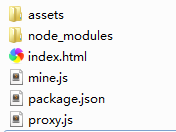情景:
前后端分离,本地前端开发调用接口会有跨域问题,一般有以下3种解决方法:
1. 后端接口打包到本地运行(缺点:每次后端更新都要去测试服下一个更新包,还要在本地搭建java运行环境,麻烦)
2. CORS跨域:后端接口在返回的时候,在header中加入'Access-Control-Allow-origin':* 之类的(有的时候后端不方便这样处理,前端就蛋疼了)
3. 用nodejs搭建本地http服务器,并且判断访问接口URL时进行转发,完美解决本地开发时候的跨域问题。
用到的技术:
1. nodejs搭建本地http服务器
2. 应用node-http-proxy,做接口url的转发
具体方法:
1. node.js搭建本地http服务器参考了shawn.xie的《nodejs搭建本地http服务器》
2. node.js做转发使用node-http-proxy实现,官方文档:https://github.com/nodejitsu/node-http-proxy#using-https
3. 操作方法参考了:http://hao.jser.com/archive/10394/?utm_source=tuicool&utm_medium=referral
4. 下面是我自己的实战操作
项目准备
1. npm初始化
npm init
2. 安装node-http-proxy模块
npm install http-proxy --save-dev
3. 项目结构

下面的例子中,我们把html文件直接放在根目录'./',也可以指定一个网站目录,在proxy.js中可以自定义
配置HTTP服务器和PROXY转发
var PORT = 3000; var http = require('http'); var url=require('url'); var fs=require('fs'); var mine=require('./mine').types; var path=require('path'); var httpProxy = require('http-proxy'); var proxy = httpProxy.createProxyServer({ target: 'http://192.168.10.38:8180/', //接口地址 // 下面的设置用于https // ssl: { // key: fs.readFileSync('server_decrypt.key', 'utf8'), // cert: fs.readFileSync('server.crt', 'utf8') // }, // secure: false }); proxy.on('error', function(err, req, res){ res.writeHead(500, { 'content-type': 'text/plain' }); console.log(err); res.end('Something went wrong. And we are reporting a custom error message.'); }); var server = http.createServer(function (request, response) { var pathname = url.parse(request.url).pathname; //var realPath = path.join("main-pages", pathname); // 指定根目录 var realPath = path.join("./", pathname); console.log(pathname); console.log(realPath); var ext = path.extname(realPath); ext = ext ? ext.slice(1) : 'unknown'; //判断如果是接口访问,则通过proxy转发 if(pathname.indexOf("mspj-mall-admin") > 0){ proxy.web(request, response); return; } fs.exists(realPath, function (exists) { if (!exists) { response.writeHead(404, { 'Content-Type': 'text/plain' }); response.write("This request URL " + pathname + " was not found on this server."); response.end(); } else { fs.readFile(realPath, "binary", function (err, file) { if (err) { response.writeHead(500, { 'Content-Type': 'text/plain' }); response.end(err); } else { var contentType = mine[ext] || "text/plain"; response.writeHead(200, { 'Content-Type': contentType }); response.write(file, "binary"); response.end(); } }); } }); }); server.listen(PORT); console.log("Server runing at port: " + PORT + ".");
MINE.JS
这里参考shawn.xie的源码,补充了几个字体文件的mime。
exports.types = { "css": "text/css", "gif": "image/gif", "html": "text/html", "ico": "image/x-icon", "jpeg": "image/jpeg", "jpg": "image/jpeg", "js": "text/javascript", "json": "application/json", "pdf": "application/pdf", "png": "image/png", "svg": "image/svg+xml", "swf": "application/x-shockwave-flash", "tiff": "image/tiff", "txt": "text/plain", "wav": "audio/x-wav", "wma": "audio/x-ms-wma", "wmv": "video/x-ms-wmv", "xml": "text/xml", "woff": "application/x-woff", "woff2": "application/x-woff2", "tff": "application/x-font-truetype", "otf": "application/x-font-opentype", "eot": "application/vnd.ms-fontobject" };
以上就是全部源码
然后把项目中的接口地址改成http://localhost:3000/......
启动nodejs服务
启动cmd,定位到项目目录,运行
node proxy.js
访问:
http://localhost:3000/index.html
可以看到项目中调用的http://localhost:3000/..... 都会从http://192.168.10.38:8180/...... 获取数据,然后转发到本地。
这样就不存在跨域了。
以上所述是小编给大家介绍的Node.js配合node-http-proxy解决本地开发ajax跨域问题,希望对大家有所帮助,如果大家有任何疑问请给我们留言,小编会及时回复大家的。在此也非常感谢大家对查字典教程网的支持!


